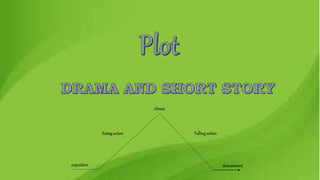Creative Writing.pptx
- 2. ` exposition This usually occurs at the beginning of a story. The first part of the plot establishes the main characters/protagonists and setting. We need to know whoâs who. Also, when and where the story takes place. At this point, the reader is just getting to know the world of the story and what itâs going to be all about.
- 3. Rising Action In this part of the plot, the primary conflict is introduced (if it hasnât been already) and is built upon to create tension both within the story and the reader, who should ideally be feeling more and more drawn to the text. The conflict may affect one character or multiple characters.
- 4. CLIMAX This is the turning point of the story. Usually, the main character comes face to face with the main problem or conflict. It is often the most exciting part of the story.
- 5. Falling action This is where any conflicts that arose as a result of the climax can start being resolve.
- 6. denouement This final plot point is when everything has been wrapped up and the new worldâand the new sense of normalcy for the charactersâ has been established. The conflict from the climax has been resolved, and all loose ends have been neatly tied up.
- 8. In the drama, all its plot structure is shown, acted and performed in stage or theatre and watch by the audience. While in the short story more in imagination, short story is usually fiction and a written work, the author only explains and describes the plot structure of the story, especially the characters and places when and where the story happened.







